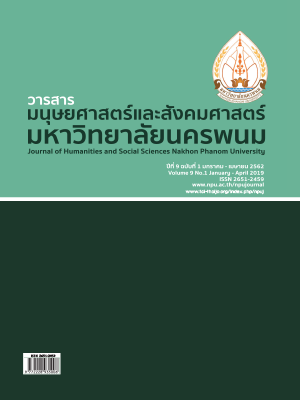Development of a Community Diabetes Care Model of Primary Health Care Service Units, Health District 10
Main Article Content
Abstract
The purposes of this study were: (1) to investigate the factors affecting care-taking of diabetes patients in the community of the Primary Health Care Units in the Health Provider Region 10; (2) analyze the relation between the factors affecting care-taking of diabetes patients in the community of the Health Provider Region 10; and (3) analyze the stratified multiple regression equation. The samples were 400 diabetes patients under the care-taking of the sub-district health promotion hospitals. The research instrument was a five-level rating scale questionnaire with content validity of .80-1.00 and reliability of 0.88. The statistical procedures were mean, standard deviation, Pearson’s co-efficiency correlation, and enter, stepwise regression analysis.
The research findings were: (1) As a whole, the factors affecting care-taking of diabetes patients in the community with the latest sugar level accumulated in the blood (HbA1C) lower than 7 and more than 7 were at a good level; (2) there were both positive and negative relation between the factors affecting care-taking of the diabetes patients in the community with the coefficiency correlation of -.121-.903; and (3) the predictive factors affecting care-taking of the diabetes patients with HbA1C lower than 7 had three variables, namely: food, physical excercises, and personnel responsible for care-taking and controlling sugar in the blood, with predictive power of 13.5%. The group of HbA1C higher than 7 with predictive power of 22.2% had four variables, namely: the personnel responsible for care-taking and controlling sugar in the blood, the food personnel, perception of risks, and sugar control.
Article Details
References
จุฬาภรณ์ พูลเอี่ยม และสุทธิพล อุดมพันธุรัก. (2557) . “การคำนวณขนาดตัวอย่างด้วยวิธีของ Taro Yamane”. วารสารการส่งเสริมสุขภาพและอนามัยสิ่งแวดล้อม. 37(1); 33-36.
เจษฎากร โนอินทร์, ทิพย์วาที มีจันโท, สุกัญญา กัญศรีและพิสิษฐ์ พูลประเสริฐ. (2560). “พฤติกรรมการดูแลตนเองของผู้ป่วยเบาหวานในเขตพื้นที่โรงพยาบาลส่งเสริมสุขภาพตำบลพลายชุมพล อำเภอเมือง จังหวัดพิษณุโลก”. ใน
รายงานการประชุมวิชาการ การนำเสนอผลงานวิจัยระดับชาติ เครือข่ายบัณฑิตศึกษา มหาวิทยาลัยราชภัฏภาคเหนือ ครั้งที่ 17 ณ ศูนย์วัฒนธรรมภาคเหนือตอนล่าง มหาวิทยาลัยราชภัฏพิบูลสงคราม. หน้า 2651-2663.
บุญชม ศรีสะอาด. (2556). วิธีการทางสถิติสำหรับการวิจัย เล่มที่ 1. (พิมพ์ครั้งที่ 5). กรุงเทพฯ : สุวีริยาสาสน์.
ประจักษ์ ปฏิทัศน์. (2560). “การตรวจสอบคุณภาพเครื่องมือวิจัย”. ใน เอกสารประกอบการฝึกอบรมการสร้างนักวิจัยรุ่นใหม่. กรุงเทพฯ : มหาวิทยาลัยราชภัฏบ้านสมเด็จเจ้าพระยา.
วิมลรัตน์ บุญเสถียร. (2557). การจัดการตนเองในผู้ที่เป็นเบาหวาน: กระบวนการของแต่ละบุคคล. วารสารการพยาบาลและการดูแลสุขภาพ. 32(4); 18-24.
สำนักงานเขตสุขภาพที่ 10. (2560). จำนวนและอัตราผู้ป่วยในด้วยโรคเบาหวาน .สืบค้นเมื่อ ธันวาคม 2560
จาก www. region10pihp.org.
สำนักโรคไม่ติดต่อ กรมควบคุมโรค. (2560). รูปแบบการบริหารการป้องกันควบคุมโรคเบาหวาน ความดันโลหิตสูง. กรุงเทพมหานคร : โรงพิมพ์ชุมนุมสหกรณ์การเกษตรแห่งประเทศไทย.
สุจิตรา บุญประสิทธิ์, สิริลักษณ์ โสมานุสรณ์และชมนาด สุ่มเงิน. (2559). “ปัจจัยที่มีความสัมพันธ์กับการจัดการตนเองในการควบคุมระดับน้ำตาล ในเลือดของผู้สูงอายุโรคเบาหวานที่ควบคุมระดับน้ำตาลในเลือดไม่ได้”. วารสารวิทยาลัยพยาบาลบรมราชชนนี กรุงเทพ. 32(1); 44-56.
สุทิน ชนะบุญ. (2560). “การวิเคราะห์ข้อมูลเชิงอนุมาน”. ใน สถิติและการวิเคราะห์ข้อมูลในงานวิจับเบื้องต้น. ขอนแก่น : สำนักงานสาธารณสุขขอนแก่น.
สุนทรี สุรัตน์, กิตติ ศศิวิมลลักษณ์, เกวลี เครือจักรและวิโรจน์ มงคลเทพ. (2559). “ความสัมพันธ์ระหว่างปัจจัยที่เกี่ยวข้องกับพฤติกรรมการดูแลตนเองของผู้ป่วยเบาหวานในพื้นที่อำเภอแม่จัน จังหวัดเชียงรายW. วารสารพัฒนาชุมชนและคุณภาพชีวิต. 4(2); 297-307.
อุระณี รัตนพิทักษ์, กีรดา ไกรนุวัตร,อภิรดี ศรีวิจิตรกมลและจุฑาทิพย์ วิภาวัฒนะ. (2556). “ผลของโปรแกรมการจัดการเบาหวานด้วยตนเองต่อความรู้พฤติกรรมและดัชนีสุขภาพในผู้เป็นเบาหวานชนิดที่ 2”. Journal of Nursing Science. 31(1); 8-18.


